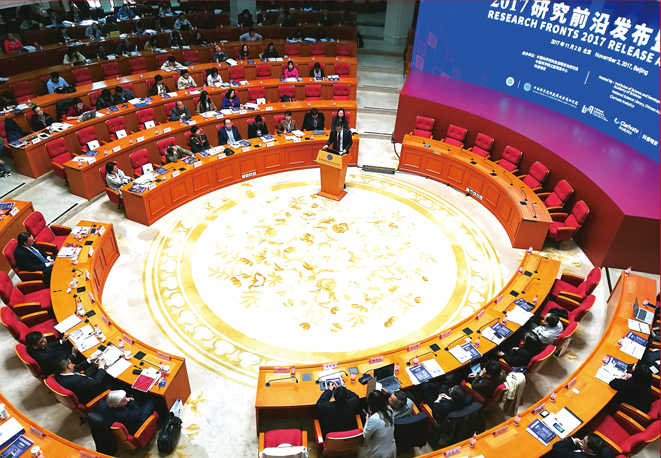By SONG Jianlan (Staff Reporter)

(Photo by ZOU Li at CASISD)
How can you tell whether or not a research area is on the frontier of a science subject? Particularly, as an “outsider” – one who is not working in a certain research area, how do you evaluate how “new” or how “advanced” it is?
An index report newly released by the Chinese Academy of Sciences (CAS) and the Clarivate Analytics offers a new lens.

CAS President Prof. BAI Chunli, head of the steering committee of the Research Fronts 2017, addresses the release. (Image by ZOU Li at CASISD)
In an era where science is sprawling at an incredible speed and scale, one can get lost in the invisible jungle of research frontiers: how do you find out the sprouting areas, especially when they are still delicate and immature, or even in amorphous structures? When we refer to an “emerging” area or specialty, what do we really mean?
This could be particularly challenging when you are not an “insider” scientist, but an S&T administrator or policy maker. Unfortunately, the ability to properly track and monitor such emerging areas is necessary before making any possible efforts to support and advance science. What shall we do?
Why not leave the choice to those who are in the know, the insider researchers?
To catch the “wild type” frontiers, a joint team adopted a smart strategy to identify hot and emerging areas of academic research, based on quantitative analysis of co-citing behavior of peer scientists themselves. On November 2, 2017, they released an index report titled Research Fronts 2017, with data and analysis indicating the rapidly growing landscape of natural and social sciences. The report represents the latest release of an annually updated serial composed by scientists and experts from the Institute of Strategic Information under the CAS Institutes of Science and Development (CASISD), the National Science Library (NSL) under CAS, and the Clarivate Analytics, a company under the Thomson Reuters offering data services in scientific and academic research.
At the same time, the team released another index report, presenting an analysis of the contributions to and potential in S&T development of different countries around the world, including the US, the United Kingdom, Germany, France, China and Japan.
“How to recognize the directions and priorities for future development is an issue of critical importance we confront, if we are to make important breakthroughs in fundamental research,” emphasized Prof. BAI Chunli, CAS President and head of the steering committee of the Research Fronts 2017, when addressing the releasing ceremony. Aside from utilizing information analysis, big data technology and state-of-the-art models and methods, including those from operational science and systems science, he introduced, the team relied on the comprehensive judgment of experts from S&T research, policy research, and strategic information analysis, and has offered an analysis and explanation to the global development and competition in the field of science and technology.
Drawing on data of publications spanning from 2011 to 2016 collected from the database Essential Science Indicators (ESI) of Clarivate Analytics, the analysis team comprised by scientists from CASISD and NSL essentially identified the most active areas by tracking the co-citing behavior of scientists themselves: they measured and ranked the frequencies at which clusters of publications addressing certain topics were commonly cited by peer scientists, and derived from the data how science is growing. With aid from big data analysis and bibliometric calculations, the team gave a detailed picture where the hottest areas are, and where new disciplines are emerging.
Particularly, when a group of highly cited papers attains a certain level of activity and coherence, said Prof. LENG Fuhai, head of the Institute of Strategic Information under CASISD, the targeted area, addressed by the cluster of papers, is defined as a “research front.” Such co-citing behavior reveals the connections among researchers working on related threads of scientific inquiry, even if the researchers’ background might not necessarily suggest such links.
To identify emerging specialties from the hot fronts, the team gave extra preference or weight to the currency of the highly co-cited literature (the “core papers” as termed by the team). Only those published very recently were counted. In other words, it is the clusters of papers that are both newly published and highly co-cited that have defined the emerging fields.

Following this methodology, the Research Fronts 2017 reveals a total of 100 “hot research fronts” and 43 “emerging research fronts” out of a total of 9,690 research fronts identified by quantitative co-citation analysis. The research fronts are classified into 10 broad areas of natural and social sciences, namely 1) agriculture, plant and animal sciences; 2) ecology and environmental sciences; 3) geosciences; 4) clinical medicine; 5) biological sciences; 6) chemistry and materials science; 7) physics; 8) astronomy and astrophysics; 9) mathematics, computer science and engineering; and 10) economics, psychology and other social sciences.
Clarivate Analytics began indexing and reporting research fronts in 2013, revealing 100 hot research fronts in the year. In 2014, the company started composing the report as a cooperative project with the National Science Library, CAS, and further tied cooperation with CASISD in 2016, to take advantage of the analysis strengths of the Academy. The three parties have been since working closely to publish the Research Fronts serial.
Offering a new lens, this serial is deemed to have provided a relatively more objective way to observe the landscape of science research, compared with the conventional methods relying on the judgment of an indexer or cataloguer. On the other hand, it reveals the cognitive and social connections by which scientists themselves forge the frontiers. Through this lens, one might be able to see how discrete fields of science emerge, coalesce, grow, and branch/evolve into other sprouting areas; or how they silence down, decline, and even dissipate.

